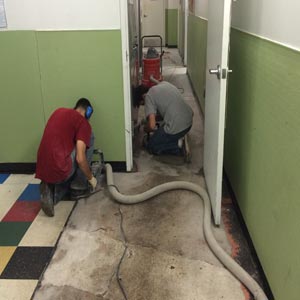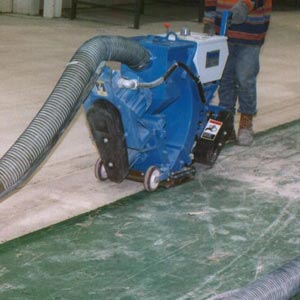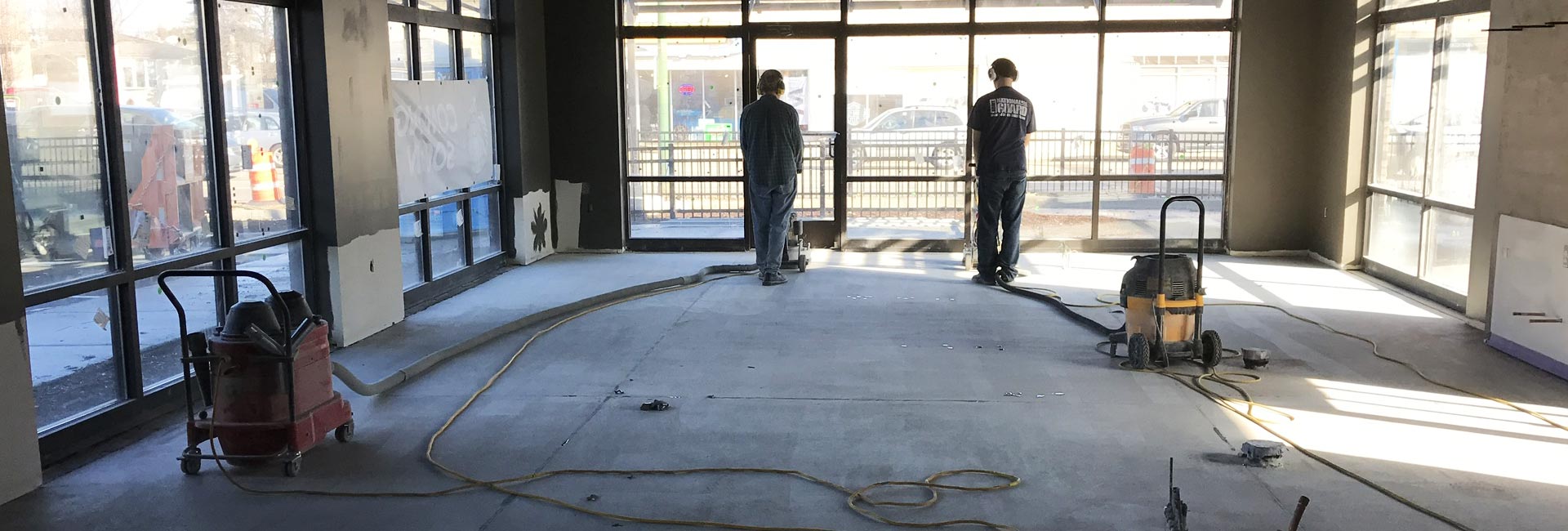Floor Preparation
Mastic Removal

The process of removing carpet mastic can be divided into two stages. In the first stage, the goal is to remove the majority of the mastic without causing any damage to the surface. The second stage involves removing the remaining thin layer of glue and creating the initial scratch pattern on the surface.
To achieve the first stage, we employ various methods to remove the bulk of the mastic without causing any harm. This includes using scraping machines, carbide scrapers, or a chemical adhesive remover. Alternatively, we may opt to use PCD diamonds or a combination of PCD diamonds with metal bond diamonds.
It is important to note that black VCT mastic has the potential to stain the concrete. Therefore, when considering a finish for the floor, it is crucial to take into account the possibility of the previous finish's outline being visible.
Shotblasting

Shotblast cleaning is a highly efficient and effective process that simultaneously strips and cleans surfaces. Unlike traditional cleaning methods, shotblasting leaves the surface completely dry and free from any chemical residue. It also eliminates the production of dust, ensuring a clean and safe working environment.
One of the significant advantages of shotblasting is that it eliminates the need to wait for the surface to dry before applying any coatings or treatments. This saves time and allows for immediate application, increasing productivity.
Although shotblasting is capable of removing thin sealers, there may be instances where additional removal procedures are required before shotblasting can be performed. This ensures the best possible results and prepares the surface for further treatment or coating.
At our company, we prioritize quality and efficiency, which is why we exclusively use Wheelabrator (US Filter) Blasttrac Portable shot blast equipment. Wheelabrator is a trusted and reputable manufacturer known for their high-performance shot blasting machines. By utilizing their Blasttrac Portable equipment, we can guarantee superior results and customer satisfaction.
Concrete Grinding

Concrete grinders are powerful machines that employ an abrasive material to effectively grind or polish concrete surfaces. The primary type of abrasive utilized on these grinders is diamond tooling, which is widely preferred due to its exceptional performance. Diamond tooling comes in various grits, ranging from a coarse 6 grit in a metal bond to extremely fine grits in the high thousands when using a resin bond tool.
The metal bond tooling is known for its durability and aggressive grinding capabilities. It is particularly useful for removing tough coatings, adhesives, or leveling uneven surfaces. On the other hand, the resin bond tooling is ideal for achieving a high-gloss finish and is commonly used for polishing applications.
In addition to the metal bond and resin bond tooling, there is also a transitional tool available, which serves as a bridge between the two. This transitional tool can be made of copper or a hybrid material, providing a balance between aggressive grinding and achieving a polished finish. It allows for a smoother transition from the metal bond to the resin bond tooling, ensuring a more refined and polished result.
Overall, the use of diamond tooling, including metal bond, resin bond, and transitional tools, is the most prevalent and effective method for grinding and polishing concrete surfaces. These tools offer versatility, durability, and the ability to achieve various finishes, making them indispensable for professionals in the concrete grinding industry.

